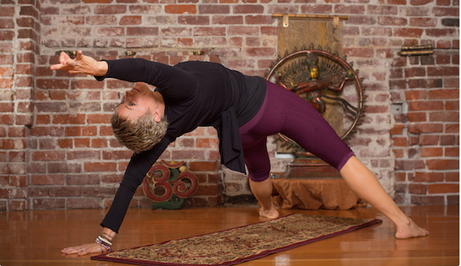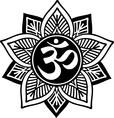
Stephanie has studied Hatha Yoga Anatomy & Kinesiology with hatha yoga experts, including Susi Hately Aldous and Julie Gudmestad. In addition, she has spent hundreds of hours immersed in self study in this area. She is continuously inspired to examine the marvels of the body in relation to hatha yoga. She relies on and consults several sources, including Yoga Journal articles on Anatomy, especially those by Julie Gudmestad, Susi Hately Aldous’s Anatomy & Asana: Preventing Yoga Injuries and also the Key Muscles of Hatha Yoga and Key Poses of Hatha Yoga books by Ray Long, PhD , and Anatomy of Hatha Yoga by David Coulter. Her greatest teachers have been her students and fellow teachers. Through their questions, she continues to reexamine the body and its mechanics and subtle energies. Here are some questions she has recently responded to:
Q
There has been some disagreement on teaching downward facing dog at the student recreation center I work at. The main issue is whether to use internal or external rotation of the shoulder or humerus. I base my knowledge and understanding of kinesiology through my own experience and that of Judith Laseter’s workshops and books. From that, I use internal rotation to find the stability of the shoulder girdle and long lengthened spine. Conversely we have an RYT 200 instructor that adamantly stresses external rotation to come into the pose.
A
Downward Dog requires full shoulder flexion of 180 degrees. The scapula needs to move into upward rotation in order to allow full shoulder flexion. Upward rotation of the scapula is a combination of protraction and depression.
Humeral external rotation IS required for shoulder flexion above 90 degrees, as well. Internal rotation of the humerus may cause possible impingement.
Take a moment to find the lower tip of the scapula on a friend – it is medial (close to the spine). Hold the tip while they bring their arm up into full shoulder flexion (circle sweeping the arm up). The lower traps and serratus anterior draw the lower medial tip of the scapula outward and then upward (this brings the top medial tip downward).
Since the hand is fixed to the mat, talking about internally or externally rotating the humerus can be complicated and confusing. Perhaps, approach alignment from moving the scapula around the humerus to allow full shoulder flexion. Here are a few simple cues I use to activate the serratus anterior in DFD which assists in the upward scapula rotation which allows full shoulder flexion without wearing the shoulders as earrings:
· Wrapping the arm pits in
· Creating a strong, broad back
· Creating lots of space between the shoulders and the ears
Q
I have heard from different yoga instructors about the potential for rotator cuff injuries if the shoulders drop below the elbows in chaturanga? Can you help me understand this better?
A
I have seen more issues with bicep tendonitis (due to humerus sinking down and fwd and rubbing into the bicep tendon) and wrist and neck stiffness due to tightness/congestion in the shoulder area more than rotator cuff injuries. However, upon further exploration there is the potential for wearing and pain over time to the supraspinatus tendon, as well? When the humerus falls forward, if it also moves up a bit toward the acromion process (most lateral and superior tip of the shoulder blade), it could wear that tendon over time and leave it vulnerable to injury. Supraspinatus is more commonly affected when a student has an overly kyphotic thoracic spine (rounded upper back) and over accentuated cervical lordosis (head forward – too much curve in neck).
The supraspinatus tendon can also become impinged in circle sweeping the arms up in tadasana or any other pose where we do that. This isnt something you may feel or even notice. Its a subtle wearing, that over time can weaken that tendon. To create more space, simply externally rotate the shoulder (palms open to the sides is a simple cue), reach fingers down, out and then up, when sweeping the arms up.
Q
It seems as I do more and more vinyasa yoga, my wrists are gradually experiencing more sensitivity. What can I do?
A
Wrist discomfort or sensitivity can come from any of the following:
1) Not fully engaging hasta bandha
2) Less than perfect shoulder girdle alignment in upper body weight bearing poses
3) Poor posture (accentuated thoracic kyphosis and cervical lordosis – upper back rounded, shoulders rounding forward, and head forward) causing congestion in the neck and shoulders that impedes blood flow and nerve transmission into/from the wrists
Hasta bandha is fully distributing the weight into the entire hand but especially the first two fingers (the “peace” fingers) to avoid pressure points and create free flow through the carpals avoiding stagnant energy in the wrists (and too much wrist extension).
In my personal experience, wrist discomfort came from less than ideal shoulder girdle alignment in upper body weight bearing poses while rehabing a shoulder. Susi’s book talks about how we experience congestion in the neck and shoulders that impedes blood flow and nerve transmission into/from the wrists. So, many times, wrist pain actually comes from the neck or shoulder. So, I spend more time on neutral spine, shoulder girdle and core stability in all fours and planks to reactivate the serratus anterior and stabilize and free the shoulders. Also, of course, doing more forearm options or using a “wrist wedge” prop. I learned this from my shoulder injuries and a brief period of wrist sensitivity and am now entirely pain-free in my yoga practice.
PLEASE NOTE – If there is pain or discomfort present in any pose or in daily life, a therapist or doctor should be consulted. Stephanie is not a doctor or therapist and is merely sharing her experience in teaching yoga as a means to see deeper into the body.
Q
There has been some disagreement on teaching downward facing dog at the student recreation center I work at. The main issue is whether to use internal or external rotation of the shoulder or humerus. I base my knowledge and understanding of kinesiology through my own experience and that of Judith Laseter’s workshops and books. From that, I use internal rotation to find the stability of the shoulder girdle and long lengthened spine. Conversely we have an RYT 200 instructor that adamantly stresses external rotation to come into the pose.
A
Downward Dog requires full shoulder flexion of 180 degrees. The scapula needs to move into upward rotation in order to allow full shoulder flexion. Upward rotation of the scapula is a combination of protraction and depression.
Humeral external rotation IS required for shoulder flexion above 90 degrees, as well. Internal rotation of the humerus may cause possible impingement.
Take a moment to find the lower tip of the scapula on a friend – it is medial (close to the spine). Hold the tip while they bring their arm up into full shoulder flexion (circle sweeping the arm up). The lower traps and serratus anterior draw the lower medial tip of the scapula outward and then upward (this brings the top medial tip downward).
Since the hand is fixed to the mat, talking about internally or externally rotating the humerus can be complicated and confusing. Perhaps, approach alignment from moving the scapula around the humerus to allow full shoulder flexion. Here are a few simple cues I use to activate the serratus anterior in DFD which assists in the upward scapula rotation which allows full shoulder flexion without wearing the shoulders as earrings:
· Wrapping the arm pits in
· Creating a strong, broad back
· Creating lots of space between the shoulders and the ears
Q
I have heard from different yoga instructors about the potential for rotator cuff injuries if the shoulders drop below the elbows in chaturanga? Can you help me understand this better?
A
I have seen more issues with bicep tendonitis (due to humerus sinking down and fwd and rubbing into the bicep tendon) and wrist and neck stiffness due to tightness/congestion in the shoulder area more than rotator cuff injuries. However, upon further exploration there is the potential for wearing and pain over time to the supraspinatus tendon, as well? When the humerus falls forward, if it also moves up a bit toward the acromion process (most lateral and superior tip of the shoulder blade), it could wear that tendon over time and leave it vulnerable to injury. Supraspinatus is more commonly affected when a student has an overly kyphotic thoracic spine (rounded upper back) and over accentuated cervical lordosis (head forward – too much curve in neck).
The supraspinatus tendon can also become impinged in circle sweeping the arms up in tadasana or any other pose where we do that. This isnt something you may feel or even notice. Its a subtle wearing, that over time can weaken that tendon. To create more space, simply externally rotate the shoulder (palms open to the sides is a simple cue), reach fingers down, out and then up, when sweeping the arms up.
Q
It seems as I do more and more vinyasa yoga, my wrists are gradually experiencing more sensitivity. What can I do?
A
Wrist discomfort or sensitivity can come from any of the following:
1) Not fully engaging hasta bandha
2) Less than perfect shoulder girdle alignment in upper body weight bearing poses
3) Poor posture (accentuated thoracic kyphosis and cervical lordosis – upper back rounded, shoulders rounding forward, and head forward) causing congestion in the neck and shoulders that impedes blood flow and nerve transmission into/from the wrists
Hasta bandha is fully distributing the weight into the entire hand but especially the first two fingers (the “peace” fingers) to avoid pressure points and create free flow through the carpals avoiding stagnant energy in the wrists (and too much wrist extension).
In my personal experience, wrist discomfort came from less than ideal shoulder girdle alignment in upper body weight bearing poses while rehabing a shoulder. Susi’s book talks about how we experience congestion in the neck and shoulders that impedes blood flow and nerve transmission into/from the wrists. So, many times, wrist pain actually comes from the neck or shoulder. So, I spend more time on neutral spine, shoulder girdle and core stability in all fours and planks to reactivate the serratus anterior and stabilize and free the shoulders. Also, of course, doing more forearm options or using a “wrist wedge” prop. I learned this from my shoulder injuries and a brief period of wrist sensitivity and am now entirely pain-free in my yoga practice.
PLEASE NOTE – If there is pain or discomfort present in any pose or in daily life, a therapist or doctor should be consulted. Stephanie is not a doctor or therapist and is merely sharing her experience in teaching yoga as a means to see deeper into the body.
